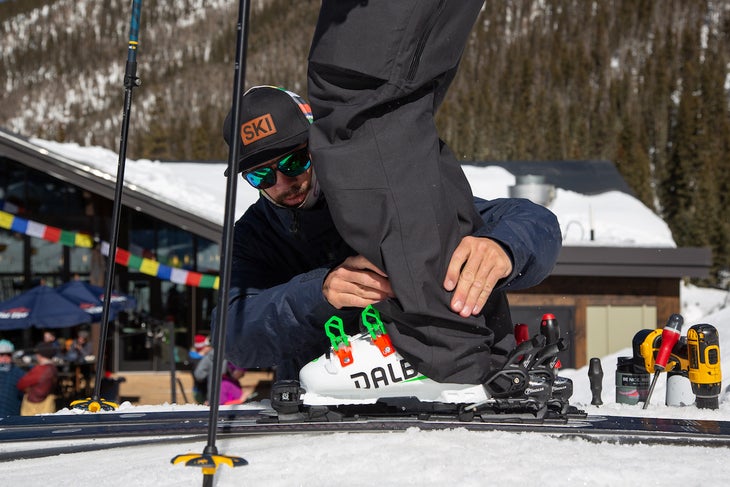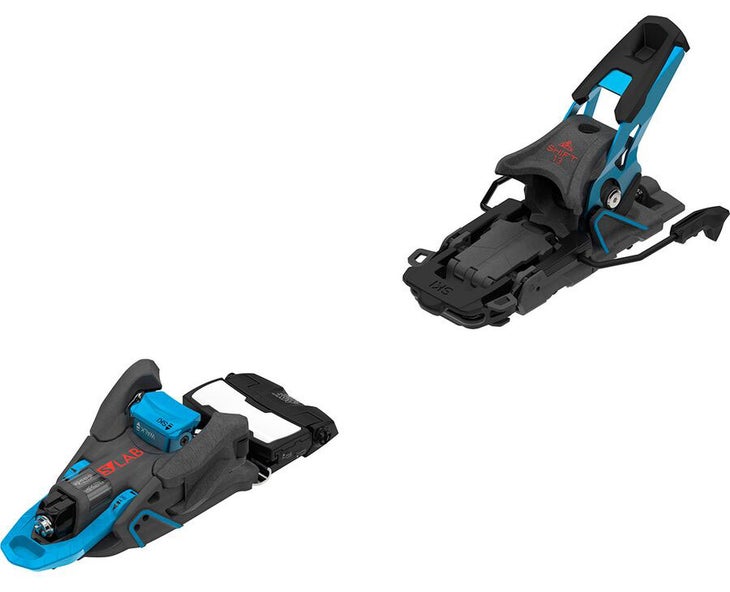Products You May Like
In October of 2016, Jeff Campbell stood on stage at the Northwest Snow and Avalanche Workshop in Seattle put on by the Northwest Avalanche Center (NWAC), just a few weeks shy of finishing his PhD in mechanical engineering at the University of Washington. A Utah native who racked up more than 100 ski days per season during undergrad, Campbell specialized in biomechanics in grad school—studying the human body as a mechanical structure and its limitations with regard to risk of injury. His presentation, titled “Alpine Touring Equipment: Retention and Release in the Backcountry,” was a summary of his research into the compatibility of various types of ski boots and backcountry ski bindings on the market at the time. His findings didn’t paint a pretty picture.
“You and your buddies could all have the same binding but a different boot and have very different experiences in that binding,” he warned the crowd of mostly avalanche professionals. He was referring to the discrepancy in binding release incidents.
At the time, backcountry touring was steadily becoming more mainstream, thanks in part to the innovation in alpine touring gear. With more boot and binding options hitting the market, skiers wanted to know if they could use their alpine touring (AT) setups to pull double duty at the resort, or even mix and match AT boots with alpine or AT frame bindings (like a Fritschi Diamir or Marker Duke).
The Problem with Mixing and Matching Alpine and Hybrid Boots/Bindings

To study their compatibility, Campbell’s team put 180 boot and binding combinations into a standardized torque testing device in a laboratory. They found that all the alpine boots and bindings released at their specified load, while 91 percent of AT boots did not. Forty-three percent of the alpine bindings tested with AT boots broke, while 25 percent of AT frame bindings tested with an AT boot also broke under force.
Related: Ski boot and binding compatibility—what you need to know
A common misconception is that alpine bindings are generally stronger than AT bindings, but these results demonstrate that’s not necessarily the case. How durable and safe a binding is depends primarily on boot-compatibility, and the amount of friction between binding and boot.
Alpine boots (or downhill boots) traditionally have a slick glide plate underfoot to help them release from the anti-friction device (AFD) toe pad on alpine and frame bindings. AT boot soles, however, have thicker, sticky rubber soles for maximum traction. These soles overwhelm AFDs and bottom out the dynamic, spring-loaded teflon pads underfoot before breaking the binding—or your leg or knee.
“Contrary to everyone’s belief, a sliding AFD actually does the worst in that configuration, which is what most hybrids [bindings] have,” says Campbell. “Because of the friction involved, the load would break no matter what the tension screws are set to.”
Hybrid bindings like the Salomon Shift, which came out in 2018, still use this AFD technology in downhill mode. Companies test them for safety with their own boots, but the big problem is that these boot/binding interfaces were never standardized across the industry, so different brands’ equipment may lack compatibility with others’, even though skiers don’t often buy boot/binding combinations according to like-brands.
The same compatibility issues arise with pin bindings and their corresponding metal boot inserts. Unfortunately, not all tech boot inserts are made to the same width specs, so the tension needed to retain or release the boots properly varies between boot brands, another situation that Campbell called “an engineering nightmare.”
Campbell now works in aerospace in Los Angeles, but isn’t confident that much has changed since 2016 as retention and release testing still isn’t standardized throughout the ski industry. Some bindings that pass the International Organization for Standardization (ISO) standards used in Europe still don’t pass the American Society for Testing and Materials (ASTM) standards, and some European bindings are only tested with boots from the same brand or ISO standard, which can negate their release/retention effectiveness as soon as you use a different brand’s boots and/or boots with a different ISO.
The Rise of Multi-Norm Compatible Boots and Bindings

“With new multi-norm boot sole and binding systems like Gripwalk being introduced, a lot has gotten more confusing and bindings haven’t been fully tested for cross-brand boot compatibility,” says Irving Scher, another biomechanical engineer and chair of ASTM’s Snow and Watersports committee who works extensively with ASTM and ISO to develop boot, binding, and ski standards to test these interfaces. “We’ve taken a 40-year step backwards by making everything more complicated. It’s what keeps me up at night.”
But Derek McClellan, Category Manager and longtime technical director for Marker Dalbello Völkl, sees a somewhat clearer path forward in the next few years. In January of 2022, MDV offered up its patented Gripwalk sole for other brands to use without paying royalties in an effort to bring all boots in the “comfort walking” alpine touring category under the standardized ISO 23223 certified norm—a multi-norm system that makes these boots compatible with GripWalk, MNC (multi-norm compatible), and pin bindings.
Many alpine and hybrid bindings on the shop shelves for the 2022-’23 season are already compatible with this boot sole system. Some can even be safely used with boots that have tech inserts.
As a result, “alpine soles will disappear except from racing and this will be the new norm in the next three years,” says McClellan.
This multi-norm system will work fine for a sidecountry setup, allowing you to do short uphill tours with heavier freeride boots with walk modes while pushing big powder skis with MNC bindings. But don’t expect any true, lightweight touring boots with thick-lugged, mountaineering-ready soles to fit into these MNC bindings. The majority of true tech/pin boots and bindings are still not certified, with some exceptions like the Dynafit Rotation and Fritschi Vipec, so you’re really skiing these at your own risk when it comes to retention and release.
The key to maximizing the performance of your boot/binding interface (and avoiding injury) is balancing your setup for what you want to ski. A lightweight pin binding isn’t designed to drive a big powder ski and will be the breaking point in that setup. A 1,000-gram alpine touring boot might have an ISO norm that’s compatible with a beefy hybrid resort binding, but from a performance standpoint, it’s not recommended you pair the two.
While the industry continues to flounder in complex non-standardization and dangerous incompatibility, here are some of Campbell’s and Scher’s guidelines for making the safest boot/binding purchase decisions you can.
Tips for buying ski boots and bindings
- Buy compatible brands. It’s wise to buy touring boots and bindings made by the same company when possible to ensure their compatibility.
- Ask the shop. Ski shops should have an idea of what combinations are compatible and which companies license their technologies to other companies. For example, Scarpa boots use Dynafit toe inserts and therefore work properly with Dynafit bindings; K2 boots use Marker/Dalbello inserts and therefore work with Marker bindings; and Fischer boots license GripWalk from Marker and therefore work with any GripWalk-compatible bindings.
- Don’t lock out your pin binding toes on the downhill or when crossing high-risk avalanche terrain. Not only does this triple your risk of serious injury if the binding doesn’t release when it’s supposed to, but it permanently damages your boot’s toe insert under stress, which will make the boot release easier than it’s supposed to.
- Be wary of the shop’s retention/release test. According to Campbell’s data, 35 percent of bindings that would pass a common shop test (Vermont Ski Safety, Wintersteiger, etc.) with a torque wrench would not have passed his lab’s and ASTM’s standardized test.
Ski boot and binding terminology
Alpine ski boots
Traditional downhill boots that feature a slick, plastic sole instead of a rockered rubber sole; these boots also do not feature metal toe inserts
Alpine ski bindings
Traditional downhill bindings that are designed to be compatible with alpine ski boots
AFD
“Anti-friction device,” the metal plate integrated into the toe piece of traditional alpine bindings and some hybrid bindings
AT
“Alpine touring,” used to describe ski boots and bindings that are designed for touring use
Hybrid
A term used to describe ski boots and bindings that can be used as a traditional downhill setup or be used for alpine touring
ISO
“International Organization for Standardization” standards; ski boots and bindings are certified with a specific ISO norm that indicates what boot/binding category they’re compatible with
GripWalk
A boot sole and binding technology first engineered by Marker. GripWalk ski boots feature a rockered, rubber sole to make walking in boots easier; GripWalk bindings are engineered to be compatible with these types of rubber soles. GripWalk boots and bindings meet ISO norm 23223.
MNC
“Multi-norm compatible;” MNC boots and bindings are designed to be compatible with a variety ski and binding types, including traditional alpine (ISO 5355), alpine touring (ISO 9523), GripWalk (ISO 23223), and Walk-to-Ride systems (WTR).
2023 Gear Reviews
The best new bindings of 2023
The best backcountry ski boots of the year
The best high-performance alpine boots of 2023
